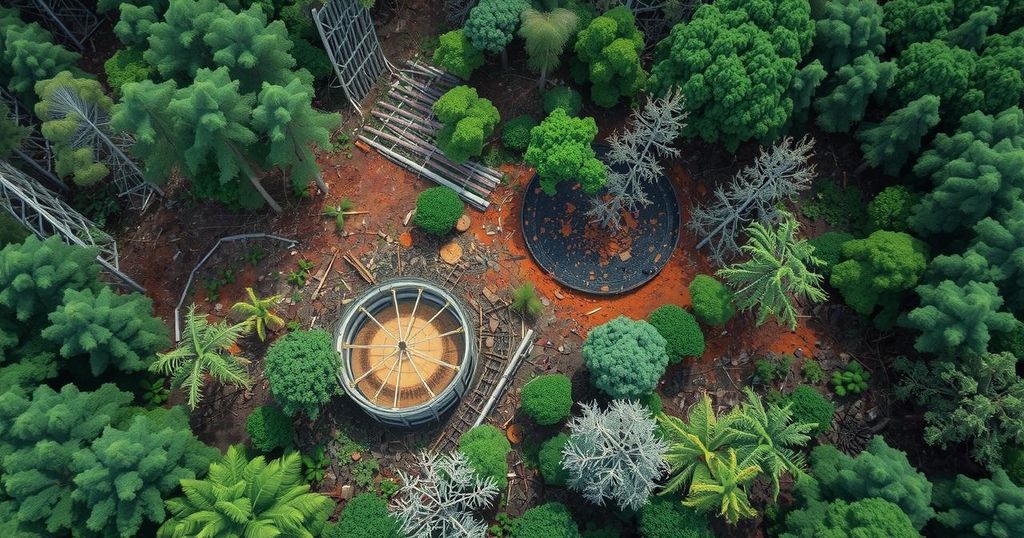The world is significantly lagging in its efforts to halt deforestation, with 6.37 million hectares lost in 2023 alone. The “2024 Forest Declaration Assessment” calls for urgent government action to address critical threats to forests. Emphasizing the role of Indigenous communities and the necessity of innovative monitoring technologies, the report outlines the need for immediate restoration initiatives and robust policies to curb deforestation, especially within the EU, which faces increasing pressures on its forested areas.
The global efforts to combat deforestation and forest degradation are critically off course, with 6.37 million hectares of forest lost in 2023 alone despite international commitments aimed at reversing these trends by 2030. The recent report, “2024 Forest Declaration Assessment: Forests Under Fire,” emphasizes the urgent need for immediate government action to address ongoing human-driven threats such as deforestation, degradation, and rampant wildfires. Although forest restoration is feasible, it cannot substitute for the intricate functions of original ecosystems.
Significant tropical deforestation and primary forest loss continue, compounded by insufficient data and monitoring practices hindering restoration initiatives. To align with global environmental objectives, urgent measures must be taken to prioritize forest conservation, decrease overconsumption, and implement extensive restoration projects. Governments are urged to adopt a human-rights-based approach, enforce protected area regulations, and manage fire patterns effectively. These measures are deemed essential for sustaining forests and their critical ecosystem services.
Forest researcher Robert Nasi highlights the dual reality of progress and obstacles facing global forests in 2024. Technological innovation and international cooperation offer hope, yet severe pressures persist. Countries like Brazil and Indonesia have made noteworthy advancements in curbing deforestation through strict regulations and sustainable management, aided significantly by satellite imagery for monitoring. Moreover, the traditional practices of Indigenous communities are gaining recognition for their contributions to forest conservation, particularly in regions like the Amazon.
Nonetheless, Nasi warns that climate change remains a pervasive challenge, driving detrimental effects such as rising temperatures and increased wildfire frequency. While the Amazon has seen decreases in deforestation rates, these trends contrast with rising challenges in other tropical areas, necessitating a multifaceted response that includes robust governance, sustainable agricultural practices, and the empowerment of Indigenous communities.
The European Union has articulated ambitious climate goals, yet the natural carbon sink function of European forests is under peril from extreme weather, diseases, and unsustainable practices, which risk turning forests from carbon absorbers into emitters. Critics assert that targets such as the EU’s proposed 90 percent greenhouse gas emissions reduction by 2040 are insufficient given the scale of the climate crisis, especially with 2024 expected to be among the hottest years recorded.
An authoritative position paper from the World Wildlife Fund (WWF) underscores the pressing need for nature protection, reinforcing biodiversity legislation, and prioritizing nature-based climate adaptation solutions. The WWF advocates for raising the 2030 emissions reduction target to a minimum of 65 percent while significantly curtailing energy consumption and phasing out fossil fuels by 2030.
The push for a complete transition to renewable energy by 2040 is also crucial, alongside a just transition framework to support vulnerable communities. Additionally, increased international climate finance is paramount to assist developing nations, reflecting the EU’s historical emissions responsibilities and its fairness in contributing to global climate efforts.
Deforestation and forest degradation have emerged as critical environmental challenges, significantly contributing to climate change and biodiversity loss. The dynamics of forest ecosystems are complex, and while restoration can take place, it cannot replicate the full functionality of these original environments. This article contextualizes the urgent need for global cooperation and government action to reverse forest loss, particularly in light of increasing pressures from human activities, climate change, and unsustainable resource use, all of which exacerbate global environmental disparities. Innovations in monitoring technology and the role of Indigenous peoples in sustainable forest management are also discussed as vital components in addressing deforestation. The European Union’s policy stance illustrates the challenges of balancing ambitious climate targets with the realities of ecological degradation in their forests. Overall, the need for a comprehensive and multifaceted approach is underscored to align actions with global environmental targets effectively.
The report on global deforestation highlights alarming trends that necessitate urgent government intervention and a concerted international response. Forest restoration, while necessary, cannot substitute for the protection of existing ecosystems. As climate change intensifies, the need for ambitious targets, equitable management practices, and the involvement of Indigenous communities grows ever more critical. The role of European forests as carbon sinks must also be preserved through meaningful policy implementation and innovative approaches to conservation and restoration. Only through these collective efforts can we hope to mitigate the impacts of deforestation and protect our planet’s biodiversity and climate system.
Original Source: www.euractiv.com






